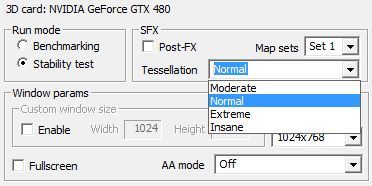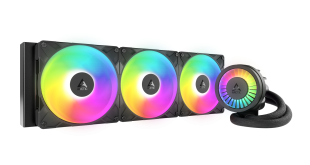This new GPU tool, called TessMark, is small synthetic graphics benchmark focused on one of the main features of Direct3D 11 and OpenGL 4 capable cards, focusing on GPU tessellation.
Like Unigine Heaven, TessMark allows to select the level of tessellation. The small difference is that TessMark offers four different levels

- moderate = tessellation factor of 8
- normal = tessellation factor of 16
- extreme = tessellation factor of 32
- insane = tessellation factor of 64
Moderate and normal levels are levels we’ll find in real world applications like games. Extreme and insane levels are not really realistic ‘real world’ tests. We are using the normal and moderate settings today.
The extra 160 shaders really aid Tessmark's performance levels, especially with the moderate setting, seeing a huge 36.8 percent increase over the stock 13,675 result with 960 unified shaders onboard. When the tessellation factor is increased from 8 to 16, the percentage increase drops to 14.3 percent.
 KitGuru KitGuru.net – Tech News | Hardware News | Hardware Reviews | IOS | Mobile | Gaming | Graphics Cards
KitGuru KitGuru.net – Tech News | Hardware News | Hardware Reviews | IOS | Mobile | Gaming | Graphics Cards




Fascinating stuff Zardon. thanks for the info, I feel more educated now 😉
Excellent, the 960 performance is great, but I can see how the 1120 shaders can enhance the results, thats for sure.
I ordered a 6870 on Friday, good reading thanks 🙂
If a few of these get leaked outside review sites they would be worth some money in the future, as a product never released 🙂
Very interesting, and ive never seen a ‘shader’ based review before. they really do make a difference, depending on the engine.
fascinating read, thank you.
3dmark gets a nice boost of a 1000 points or so, nice.
Heh, shame they didnt start selling these !
This is a lesson in shader power and how important it is. would have been awesome if they had sold these in stores for the same price 🙂 a quick OC and its 6870 goodness at less money.
Great to get facts rather than speculation. testing is really useful.
Can AMD hardlock cards from being overclocked? I thought they could. they should have sold t he 6850 at the same price with 1120 shaders, but hardlocked it so it couldnt be overclocked.
Only downside with that Garry is that people would be able to hack the bioses to get the clock speeds up. then they basically could get a 6870 for 140 quid rather than 200. but i like the idea. a locked 775 core 6850 with shader power of 6870 which would be clocked at 900mhz and able to be overclocked. i think they would sell more, but it might stop sales of 6870 long term.
The Tessmark result is strange. How can you get a 36.8% performance increase with 16.7% more shaders? Must be something else at play.
Absolutely – no idea, but ive asked the program author to comment.
Amazes me at times how many sites do little research, I saw one other writer saying kitguru had run tests with a 1120 shader HD6850 in previous reviews. Yet here we are looking at this article and the 960 shader results in this match the sapphire and XFX reviews published last week for the 960 cards. the 1120 cards are clearly much better performers. Thanks for the info, very good read.
I think the news here on kitguru, while controversial and funny at times tends to damage the amazing quality of the reviews.
Thanks, my HD6850 arrived and my results are much the same as the 960 core version in this article. Bit of a bummer they didn’t let a few 1120 shader versions out into the wild as the differences are quiet noticeable.